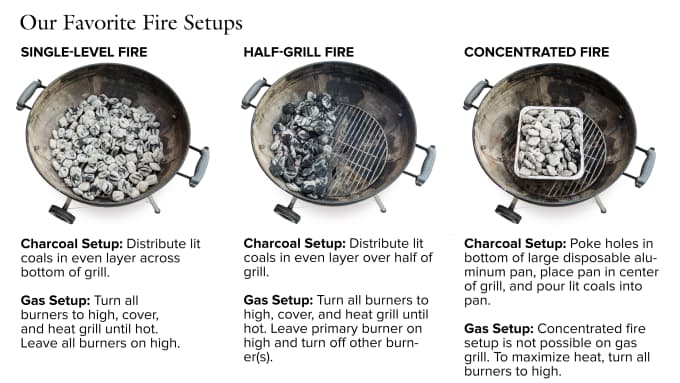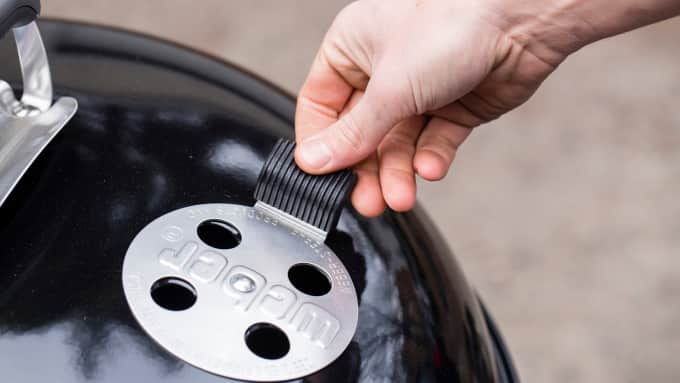We've all encountered grease flare-ups, coals that take forever to ignite, and food that sticks to the grates. The good news is that every one of these issues is avoidable. Here are our best practices for avoiding common grilling mistakes.
Mistake #1: Using lighter fluid
Applies to: Charcoal grills
Why It's a Bad Idea: Lighter fluid can impart a chemical flavor to the food.
Best Practice: Light coals in a chimney starter.


The Best Chimney Starters
If you grill with charcoal, you need a chimney starter. Does it matter which one you buy?Buy the Winner
Read Our ReviewMistake #2: Packing too much paper into the chimney
Applies to: Charcoal grills
Why It's a Bad Idea: Doing so blocks airflow, so the coals will take longer to ignite—or will not ignite at all. Read about our experiment proving that more tinder isn't better.
Best Practice: Don’t place more than two sheets of newspaper in the bottom chamber at one time. (And if you don't have newspaper, learn about other kinds of paper that work well for lighting the coals.)

Mistake #3: Pouring the coals before they are fully ignited
Applies to: Charcoal grills
Why It's a Bad Idea: If the coals aren’t hot enough, they won’t cook food at the right rate. Or, worse, the fire can die out.
Best Practice: Don’t pour the coals until the top layer is partially covered with ash—a sure sign that they’re ready.

Mistake #4: Skipping the preheat step
Applies to: Charcoal and gas grills
Why It's a Bad Idea: Meat placed on a cooking grate that’s not sufficiently hot will stick aggressively because its proteins form a chemical bond with the metal.
Best Practice: Wait to add food until the metal is very hot. This will break the bonds (which are thermally unstable), preventing sticking. It will also produce much better color and char. Gas grills also need longer than charcoal grills to preheat. Learn more about what happens if you try to cut the process short by clicking here.

Mistake #5: Using one fire setup for all tasks
Applies to: Charcoal and gas grills
Why It's a Bad Idea: The fire setup—how much charcoal or how many burners you’re using and where the heat is located in relation to the food—allows you to control the heat level and the rate of cooking. Using the wrong setup can cause food to burn before it’s cooked through or cook through without developing any flavorful browning or char.
Best Practice: Use the fire setup for that's appropriate for the type of food you're grilling. We use 3 main fire setups, and follow these guidelines when choosing which to use.
| FIRE TYPE | BEST FOR |
|---|---|
Single-Level Fire | Small, quick-cooking foods such as sausages, shrimp, fish fillets, and some vegetables. |
Half-Grill Fire | Foods that you want to cook gently but also sear, such as bone-in chicken parts and pork chops. |
Concentrated Fire | Quick-cooking foods on which you want substantial char, such as burgers or thin steaks. |


The Best Gas Grills Under $500
It doesn’t matter how powerful a grill is. If it can’t distribute and hold the heat where you want it, your food will suffer.Buy the Winner
Read Our Review
Charcoal Grills
We’ve happily made do with Weber’s basic kettle for years. But would newer, more tricked-out charcoal cookers be worth the upgrade?Buy the Winner
Read Our ReviewMistake #6: Not oiling the cooking grate
Applies to: Charcoal and gas grills
Why It's a Bad Idea: Most cooking grates are made of steel or cast iron and must be oiled before grilling to keep food from sticking.
Best Practice: Using tongs, dip a wad of paper towels in vegetable oil and thoroughly wipe the preheated, scrubbed cooking grate before adding food.


The Best Grill Tongs
What qualities separate the best grill tongs from the pretenders?Buy the Winner
Read Our ReviewMistake #7: Not checking the propane tank
Applies to: Gas grills
Why It's a Bad Idea: You don’t want to end up with an empty propane tank in the middle of grilling—especially in the case of a lengthy project such as brisket or ribs.
How to check the tank:
If your grill does not have a built-in fuel gauge, you can buy an external one—for example, the intuitive Original Grill Gauge. Or try this hot water trick: Boil 1 cup of water and pour it down the side of the tank. Feel the metal with your hand. Where the water has warmed the surface of the tank, it is empty; where the tank remains cool to the touch, there is still propane inside.

Mistake #8: Cooking on a gunked-up grill
Applies to: Charcoal and gas grills
Why It's a Bad Idea: Food debris, grease, and smoke that build up on various parts of the grill can cause sticking and impart off-flavors to food; full grease traps can ignite; and built-up grease on the interior basin and underside of the grill lid can carbonize and turn into a patchy layer that flakes off and lands on your food.
How to clean your grill:
- Grill grates: After preheating the grill, scrape the cooking grate clean with a grill brush.
- Interior basin and lid: Lightly scrub the cool grill and lid with steel wool and water.
- Ash catcher (charcoal only): Empty the cooled ash regularly.
- Grease traps (gas only): Remove the cool shallow pan from under your grill and scrub it with hot soapy water. To make cleanup easier, line the pan with aluminum foil before use.


Best Grill Brushes
Every brush did a decent job of cleaning, but only one made it feel easy.
Read Our ReviewMistake #9: Leaving the lid open
Applies to: Gas grills
Why It's a Bad Idea: Because gas grills deliver less heat output than charcoal models, grilling certain foods with the lid up allows too much heat to escape. Note: You should never light a gas grill with the lid down, which can trap gas and cause a dangerous explosion.
Best Practice: When directed in a recipe, keep the lid closed to trap as much heat as possible.

Mistake #10: Lifting the lid too often
Applies to: Charcoal and gas grills
Why It's a Bad Idea: This is equivalent to frequently opening the oven door. Heat will escape, which prolongs the grilling time.
Best Practice: Use a probe thermometer, which allows you to monitor food’s doneness without opening the grill.

Mistake #11: Ignoring the grill vents
Applies to: Charcoal and gas grills
Why It's a Bad Idea: If you’re not using the vents, you’re not controlling the heat output.
How Grill Vents Work:
Grill vents are like the dials on your stovetop: They allow you to manipulate how hot the fire gets and how the food cooks. Charcoal grills have top vents on the lid and bottom vents on the underside of the basin. (Gas grills have vents, too, but they are not adjustable.) In general, opening the vents completely allows more oxygen to reach the fire so that it burns hotter and faster; partially closing the vents lowers the temperature and prolongs the fire’s duration.

Mistake #12: Turning the meat too soon
Applies to: Charcoal and gas grills
Why It's a Bad Idea: Meat will stick to the cooking grate until the meat’s surface is hot enough to release (see “Mistake #4: Skipping the preheat step”). Lifting meat before it naturally releases will tear it.
Best Practice: Sear the meat without moving it until a substantial crust forms around the edges. If the meat doesn’t lift easily, continue searing until it does.

Practice some of your new grilling know-how on these great recipes:

